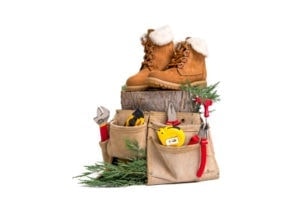
Get Out Your Snow Boots
After a big snowfall, pull on your boots and take a walk around your house. If you see areas on your roof that are melting before the surrounding areas melt, that’s a sure indicator that your insulation isn’t doing its job. Heat is escaping through your roof. Either there is less insulation in that area, or there is a leak in the roof. If there’s a leak, water has seeped in and ruined the insulating factor of your insulation. Make a mental note or a quick sketch to indicate where the melting is occurring, so you can check your attic to find the offending party.
If your eaves are forming icicles rapidly with a thaw, that is another indicator that heat is escaping through the roof.
One chore you’ll be doing all winter long is snow removal and ice control. After shoveling, check the eaves for ice dams. Break them up so the melting water flows away and ice doesn’t build up again. Knock or sweep snow from tree branches, if there is a possibility they may break under the weight of the ice and snow. If you have flat or low-angled roofs on outbuildings that have little support, sweep the snow off to minimize the dead load on the roof.
While you’re out walking around your home, check to see if you have ground water puddling next to the foundation. You may not be able to do anything right now, but now that you know where water puddles, you can keep an eye in the basement for any evidence of moisture in that area.
Examine your trees for broken limbs and remove them, if possible.
When the snow has melted off your roof, use binoculars to check for any damaged or missing shingles.
Get Out The Knee Pads
If you have a north-facing crawl space that has water pipes, block the vents with plywood to keep the temperature more moderate and help to prevent pipes freezing.
Check all vulnerable pipes that are exposed to the cold. These include pipes in outside walls, hose bibs, sprinkler lines, pipes in unheated attics, basement and garage. You can wrap these pipes with insulated pipe tape to minimize the risk of pipes freezing and bursting. There are even heated pipe coverings that are electrically powered.
Locate the location of your home’s water shut-off valve. Make sure everyone in the household knows the location and how to turn it off if a pipe bursts.
Check your forced-air heating ducts for leaks. Seal them with duct tape. Wow, you finally get to utilize that wonderful, all-purpose tape for its original, intended use.
You can also use that duct tape to seal any leaks that allow cold air in. Dryer vents and pipes that enter the house for water or electrical wiring are particularly vulnerable. You can also seal around the pipes with caulking.
 Get Out The Peanut Butter
Get Out The Peanut Butter
The majority of timber frame homes are located in rural settings. If you haven’t found out by now, you will shortly find that tiny woodland creatures will be actively trying to make their winter home in your basement and attic.
These little fellows can be a minor nuisance or cause major damage. Nuisances include leaving droppings, making nests from miscellaneous found paper and snacking on unsecured food in your pantry.
However, they can do terrible damage by chewing on your wiring. This kind of damage can short out your electrical system and cause a fire in your home.
If you have mice or rats, determine which the invader and purchase the appropriate sized traps. Peanut butter is a tasty treat and works well in luring your prey.
If you have other unwanted guests, you’ll need to research the best way of ridding your house. Squirrels, chipmunks and other furry creatures may take up residence inside your home or under porches and decks.
You’ll also need to locate the animals’ point of entry and seal the cracks or openings. Don’t be softhearted and let the little squatters make problems for the permanent residents of your home.
Get Out Your Emergency Supplies
This is a good time of year to evaluate the status of your household emergency supplies. It’s an indoor chore that sometimes gets neglected, but it’s one that every homeowner should do annually.
If you live in an area with severe winters, make sure you have a well-supplied back up heating source. Make sure there’s plenty of wood for the fireplace or wood stove, or make sure your backup generator is functioning and you have plenty of fuel for it.
Hurricane country dwellers should have a supply of plywood for protecting windows. Double check that you or the kids hasn’t commandeered plywood for summer projects, and replace them if necessary. You should also have food and water in reserve for several days for each member of the family.
If you’re a camper, keeping your camping supplies adjacent to your emergency supplies keeps everything handy in case you need them.
You should have a battery-powered or windup radio, blankets, a first aid kit, bottled water, candles, matches, flashlights and batteries. Check your batteries to ensure they have not drained. You should also have tools to turn off your water and gas lines if an emergency arises.
Get Out Your Pencil, Paper and Camera
Creating a home inventory is a good job for winter time. Everyone should have a record of your home’s architectural attributes, its condition, the furnishings and your valuable possessions. You need this information if your home is damaged by flood, fire, hurricane or other disaster. This list substantiates any insurance claim you may have and ensures that you’ll get the maximum coverage for your property and possessions.
Keep receipts for valuable purchases and work that is done to the interior and exterior of your home.
In addition to a listing of your possessions, a video or photographs of your home and its contents is a good supplement in proving any claim.
Be sure to keep a copy of these documents off-site, in the event that your home is completely destroyed.
Now’s the time to enjoy the home you’ve planned and created. Get out your holiday decorations, make up your favorite recipes for entertaining guests and invite everyone over for a fun evening or afternoon. They’ll enjoy the beauty of your timber frame home, with its rustic charm and spaciousness. You’ll be able to relax, knowing your winter maintenance projects are complete.
